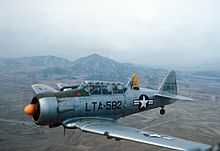6147th Tactical Control Group
| 6147th Tactical Control Group | |
|---|---|
| Active | 1951–1953 |
| Country | United States |
| Branch | United States Air Force |
| Role | Tactical Control |
The 6147th Tactical Control Group was a United States Air Force unit that fought in the Korean War. The unit was attached to Far East Air Forces Fifth Air Force
Operational Units:
- 942nd Forward Air Control Squadron: attached 20 June 1953–.
- 6148th Tactical Control Squadron: 25 April 1951–.
- 6149th Tactical Control Squadron: 25 April 1951–.
- 6150th Tactical Control Squadron: 25 April 1951 – 20 June 1953.
The 6147th Tactical Control Group originated at Taejon, South Korea, within the "operations section" of the Joint Operations Center – three pilots and two aircraft testing the airborne forward air controller concept. On 9 July 1950, two airborne controllers flew their first mission in L-17s borrowed from the USA 24th Infantry Division. Despite attacks from enemy aircraft, each controlled about ten flights of F-80s. The next day, controllers testing T-6s spotted and directed the destruction of seventeen enemy tanks. The following day the small group of controllers left for Taegu to organize as a squadron. The 6147th Tactical Control Squadron, Airborne, activated effective 1 August to provide target spotting information to tactical aircraft in flight.
After the UN landings at Inchon in late September, the squadron (nicknamed "Mosquitoes"), directed air strikes against retreating enemy troops ahead of the advancing UN lines and operated as the eyes of UN ground forces. Squadron controllers also conducted deep penetrations into enemy country, search and rescue, night direction for B-26s, parachute-drop mission coordination, and artillery adjustment. As the enemy fled, the squadron moved to Kimpo AB, where the pilots were within minutes of their working areas but also within range of enemy snipers on takeoffs and landings. By late October, the squadron had moved to Pyongyang but in December retreated to Taegu, where it returned to controlling close air support missions. In January 1951, the 6147th TCS gained a C-47 that provided an airborne radio relay between the Joint Operations Center and controllers, enabling Mosquitoes to adapt to the changing combat situation.

In April 1951, the 6147th elevated to group-level and organized three squadrons, two of which provided airborne controllers while the third provided the U.S Army with ground tactical air control parties. A year later, the group moved to Chunchon, from where it directed interdiction missions. In the closing days of the war, it assisted allied aircraft in crushing a last-minute enemy offensive in the vicinity of the Kumsong River. The 6147th TCG earned three Distinguished Unit Citations during the war.
Stations:
- Taegu AB, South Korea, (August – October 1950)
- Kimpo AB, South Korea (October 1950)
- Seoul Afld, South Korea, (October 1950)
- Pyongyang East Adrm, North Korea, (October – November 1950)
- Taegu AB, South Korea, (November 1950 – March 1951)
- Pyongtaek Adrm, South Korea, (March 1951 – April 1952)
- Chunchon, South Korea, (April 1952 – July 1953)
See also
- Pacific Air Forces
- Peter Worthington, Canadian journalist served with the 6417 Mosquito Squadron during the Korean War
References
![]() This article incorporates public domain material from websites or documents of the Air Force Historical Research Agency.
This article incorporates public domain material from websites or documents of the Air Force Historical Research Agency.
- Futrell, Robert Frank (1983) The United States Air Force In Korea, 1950–1953, Maxwell AFB, Alabama Office of Air Force History, ISBN 0-912799-71-4


